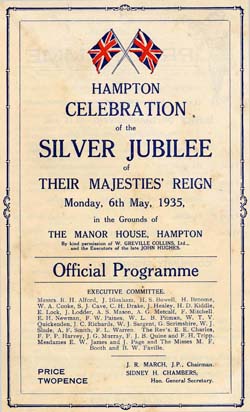Royal Celebrations
Local celebrations to mark Royal events were common in the 19th and 20th centuries

The local area has long enjoyed connections with royalty, particularly the monarchs who lived at Hampton Court Palace. However, George III, who ascended the throne in 1760 decided not to live in the Palace, which was thereafter used in part for 'Grace and Favour' apartments. In 1838, shortly after Queen Victoria's accession many of the principal rooms were opened to the general public.
Royal events, particularly Jubilees and Coronations, gave rise to local celebrations. They also were marked by the building of memorials, to record these occasions. There were Golden and Diamond Jubilees in 1887 and 1897 to mark the 50th and 60th anniversaries of the reign of Queen Victoria. George V celebrated his Silver Jubilee in 1935 and the Queen celebrated her Silver and Golden Jubilees in 1977 and 2002. Coronations, after that of Queen Victoria in 1838, were held in 1902, 1910, 1937 and 1953, for Edward VII, George V, George VI and Elizabeth II.
Locally, these celebrations were attended by thousands of people and would often involve events lasting several days. Usually the young and the elderly were treated to free meals and given presents and souvenirs. There would be a fair, sports, dancing, fireworks and a variety of entertainment - so that the whole community was involved. Many of the houses and streets would be decorated with flags and bunting.
Local Victorian Jubilee memorials included replacement almshouses in Hampton and drinking fountains in Teddington and Hampton Wick. The Golden Jubilee for Victoria also inspired other initiatives including the replacement of the east window at St. Mary's Church in Twickenham, the addition of the tower and spire at St. James's Church, Hampton Hill, and the building of the chancel at St. Mary's Church in Hampton.



